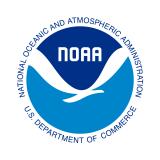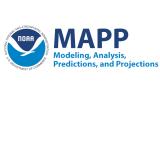Development of a Prototype High-Resolution Prediction System for Precipitation, Soil Moisture, and Streamflow over North America

Despite considerable advances in our understanding of drought mechanisms (role of sea surface temperature, land atmosphere feedbacks, etc.), there has been little improvement in drought predictions on seasonal timescales. In fact, seasonal forecast information appears to provide little additional skill to hydrologic forecasts, beyond that obtained from the initial land conditions, though some improvement can be achieved by conditioning the forecasts on the El Niño–Southern Oscillation (ENSO).
The goal of this research was to improve hydrologic (precipitation, soil moisture, streamflow) prediction skill on subseasonal to seasonal timescales by developing and evaluating a prototype drought prediction system that takes advantage of a number of recent advances in our modeling and understanding of precipitation variability, as well as improvements in the soil moisture initial conditions.
This project was part of the Modeling Analysis, Predictions, and Projections (MAPP) Program and National Integrated Drought Information System (NIDIS) supported Drought Task Force I.
For more information, please contact Amanda Sheffield (amanda.sheffield@noaa.gov).
Research Snapshot
Results of This Research
The results of this study provided important groundwork for the development of a high-resolution prediction system for precipitation, soil moisture, and streamflow over North America. This includes:
- Improved understanding of the causes of drought, and the ability of climate models forced with observed sea surface temperatures to reproduce recent high-profile events
- The establishment of a baseline for assessing any improvements in the skill of hydrologic models forced with coupled model forecasts
- An assessment of downscaling and multimodel forecasts
- A better understanding of why parts of the continental United States would not benefit from the added information contained in high-resolution precipitation forecasts.
In particular, the study identified the important role of the tropical Pacific, tropical Atlantic, and Indian Ocean sea surface temperatures, the key role of soil moisture feedbacks, and the importance of unforced internal atmospheric variability, in the development of drought over North America.
This research resulted in several peer-reviewed publications, including:
- Wood, E., S. Schubert, A. Wood, C. Lidard-Peters, K. Mo, A. Mariotti, and R. Pulwarty. 2015. “Prospects for Advancing Drought Understanding, Monitoring and Prediction.” Journal of Hydrometeorology 16, 1636–1657.
- Koster, R. D., Y. Chang, and S. D. Schubert. 2014. “A Mechanism for Land-Atmosphere Feedback Involving Planetary Wave Structures." Journal of Climate 27, 9290–9301.
- Mo, K. C., and D. P. Lettenmaier. 2014. “Objective Drought Classification Using Multiple Land Surface Models.” Journal of Hydrometeorology 15, 990–1010.
- Wang, H., S. Schubert, R. Koster, Y.-G. Ham, and M. Suarez. 2014. “On the Role of SST Forcing in the 2011 and 2012 Extreme U.S. Heat and Drought: A Study in Contrasts.” Journal of Hydrometeorology 15, 1255–1273.
- Mo, K. C. and D. P. Lettenmaier. 2014. “Hydrologic Prediction Over the Conterminous U.S. Using the National Multi Model Ensemble.” Journal of. Hydrometeorology 15, 1457–1472.
- Koster, R. D., G. K. Walker, S. P. P. Mahanama, and R. H. Reichle. 2014. “Soil Moisture Initialization Error and Subgrid Variability of Precipitation in Seasonal Streamflow Forecasting.” Journal of Hydrometeorology 15, 69–88.
- Mo, K. C., S. Shukla, D. P. Lettenmaier and L. C. Chen. 2012. “Do Climate Forecast System (CFSv2) Forecasts Improve Seasonal Soil Moisture Prediction?” Geophysical Research Letters 39, L23703.



